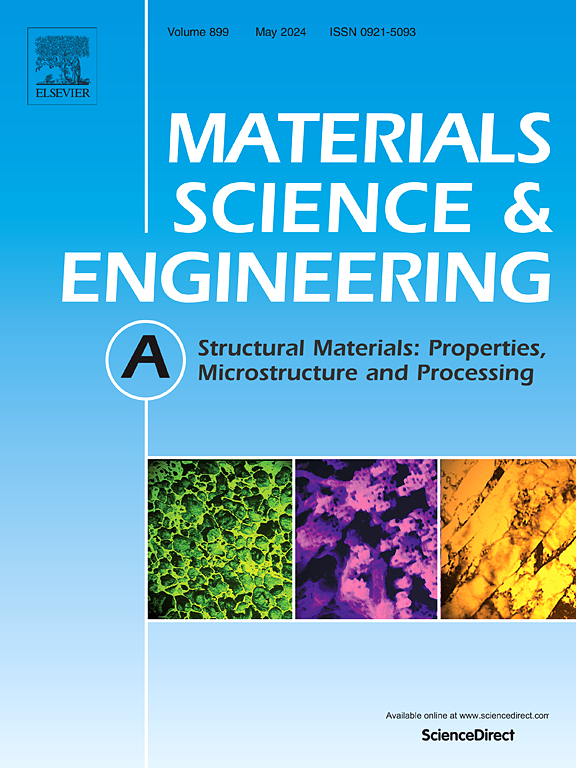亚稳六方高熵合金孪晶行为的原子水平研究
IF 6.1
2区 材料科学
Q1 MATERIALS SCIENCE, MULTIDISCIPLINARY
引用次数: 0
摘要
高熵面心立方(fcc)基体相经马氏体相变(MT)低温变形后可生成六方密堆积(hcp)结构的高熵合金(HEAs)。{10.1}变形孪生(DT)在这些变形诱导的hcp HEAs中被广泛观察到。与塑性功局部加热相对应,变形诱导的hcp相在塑性变形过程中通常是亚稳态的。hcp相的亚稳性有利于高密度基层错(bsf)和两种具有{111}孪晶关系的fcc纳米带的形成,显著影响{101 1}孪晶的传播和增厚。采用高分辨率透射电子显微镜(HRTEM)和分子动力学(MD)模拟,系统地研究了{101 - 1}DT的行为及其与变形诱导的hcp相中可逆马氏体转变(RMT)相关的bsf和fcc纳米带的相互作用。RMT (fcc↔hcp)和{111}DT的动态耦合变形机制在{101 _1}双胞胎中产生复杂的结构演化,其中RMT的运动路径受到双胞胎边界的影响。{101 1} twin和fcc纳米带之间的相互作用根据其晶体取向分为“非交叉”和“表观交叉”机制。HRTEM表征和MD模拟表明,hcp/fcc相界{101 1}孪晶位错的再成核促进了通过低取向角fcc纳米带的{101 1}孪晶传输。这些发现为亚稳态hcp HEAs的变形机制提供了深入的理解,突出了动态耦合的DT和RMT机制在塑性变形过程中控制微观组织演变的作用。本文章由计算机程序翻译,如有差异,请以英文原文为准。
Atomic-level study of twinning behaviors in metastable hexagonal high-entropy alloys
High-entropy alloy (HEAs) with a hexagonal close-packed (hcp) structure can be generated from the high-entropy face-centered cubic (fcc) matrix phase through martensitic transformation (MT) as deformed at low temperatures. {10 1} deformation twinning (DT) was widely observed in these deformation-induced hcp HEAs. Corresponding to local heating by plastic work, the deformation-induced hcp phase is generally metastable during plastic deformation. The metastability of the hcp phase facilitates the formation of high-density basal stacking faults (BSFs) and two types of fcc nano-bands with a {111} twinning relationship, significantly influencing {10 1} twin propagation and thickening. Using high-resolution transmission electron microscopy (HRTEM) and molecular dynamics (MD) simulations, we systematically investigated the behaviors of {10 1} DT and its interactions with BSFs and fcc nano-bands associated with reversible martensitic transformation (RMT) in the deformation-induced hcp phase. The dynamically coupled deformation mechanisms of RMT (fcc ↔ hcp) and {111} DT generate complex structural evolutions within {10 1} twins, where kinematic paths of RMT are influenced by twin boundaries. Interactions between {10 1} twin and fcc nano-bands are categorized into “non-crossing” and “apparent crossing” mechanisms, depending on their crystallographic orientations. HRTEM characterizations and MD simulations reveal that {10 1} twin transmission through fcc nano-bands with low misorientation angles is facilitated by indirect slip transmission via re-nucleation of {10 1} twinning dislocations from the hcp/fcc phase boundaries. These findings provide an in-depth understanding of the deformation mechanisms in metastable hcp HEAs, highlighting the role of dynamically coupled DT and RMT mechanisms in governing microstructural evolutions during plastic deformation.
求助全文
通过发布文献求助,成功后即可免费获取论文全文。
去求助
来源期刊

Materials Science and Engineering: A
工程技术-材料科学:综合
CiteScore
11.50
自引率
15.60%
发文量
1811
审稿时长
31 days
期刊介绍:
Materials Science and Engineering A provides an international medium for the publication of theoretical and experimental studies related to the load-bearing capacity of materials as influenced by their basic properties, processing history, microstructure and operating environment. Appropriate submissions to Materials Science and Engineering A should include scientific and/or engineering factors which affect the microstructure - strength relationships of materials and report the changes to mechanical behavior.
 求助内容:
求助内容: 应助结果提醒方式:
应助结果提醒方式:


